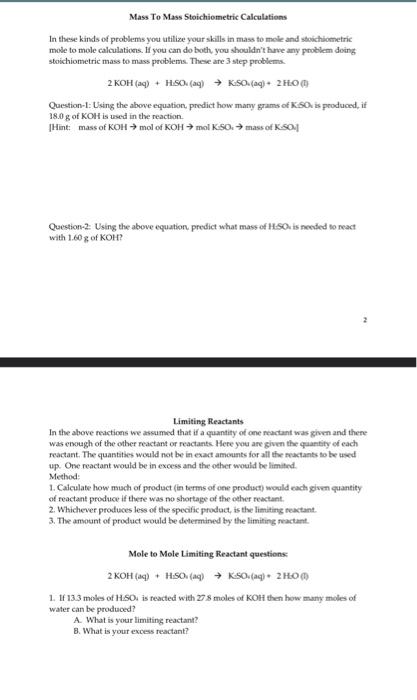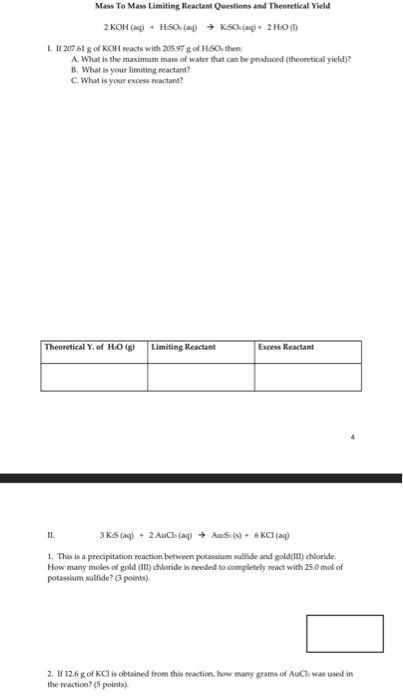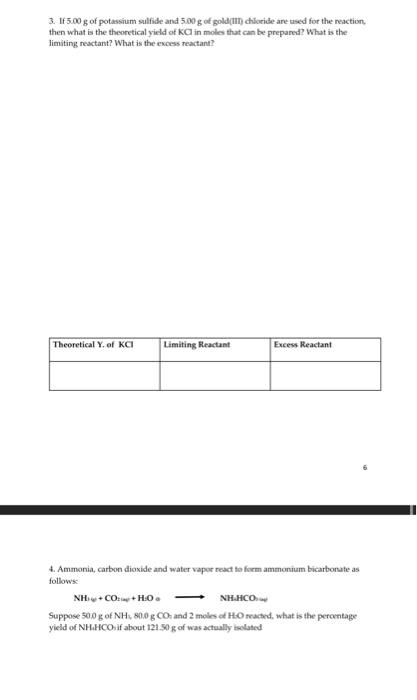Questions: What is the mass of 0.210 moles K.SO4 in grams? Stoichiometric mole to mole calculations For mole to mole calculations, ene predicts mole quantikss of reactants of products based on the provided moles of another reactant or product within the same chemical equation. You only need to use the coelficients and their ratios (mole ration) to make the necessary calculations. The following equaticen is already balanced. 2KOH(aq)+HSO(Sq)KiSO(ac)+2HO(t) Question-1: How many moles of K5O is produced if 7.00 moles of KOH is used for the reaction? Questions-2: How many moles of H.5O4 is nexded to reat with 6.00 moles of KOH ? Mass To Mass Stoichiometric Calcalations In these kinds of problems you utilise your skills in mass to mole and stoichiometric mole to mole calculations If yoa can do both, you shouldn't have ary problem doing stoichiometric mass to mass problems. These are 3 step problems, 2KOH(aq)+HSO(aq)KsOO(aq)+2HO(i) In these kinds of problems you utilize your skills in mass to mele and stoichlometric mole to mole calculations. If you can do both, you shouldn't have any problem doing stoichiometric mass to mass problems. These are 3 step problems. 2KOH(aq)+HSO(aq)KsO(aq)+2HfO(i) Question-1: Using the above equation, predict how many grams of K 80o is produced, if 18.0g of KOH is used in the reaction. [Hint: mass of KOH mol of KOH mol KSO4 mass of K.8OO ] Question-2: Using the above equation predict what mass of HSOu is needed to react with 1.60 ge of kOH ? Limiting Feactants In the above reactions we assumed that if a cquantity of one mactant was given and there was enough of the other reactant of reactants. Here you are given the quantity of each reactant. The quantitges weeld not be in exact ameunts for all the feuctants to be uxed up. One reactant would be in excess and the other would be limited. Method: 1. Calculate how much of product (in terms of one product) would cach given quantity of reactant produce if there was no shortage of the ether reactant. 2. Whichever produces less of the specific product, is the limiting reactant. 3. The amount of product would be determined by the limiting reactunt. Mole to Mole Limiting Reactant questions: 2KOH(aq)+HSOv(aq)KSOv(aq)+2HO(H) 1. If 13.3 moles of H4SO4 is reacted with 278 moles of KOlt then how many moles of water can be produced? A. What is your limiting reactant? B. What is your excess reactant? Mass To Mass Limiting Reactast Qeestions and Theoretical Yield 2KOH(aq)+HSOS(aq)KSON(aq)+2HOO(D) 1. If 207.61g of KOH reacts with 205.97 \& of H:80, then: A. What is the maximam mass of water that can be produoind (thevretical yieid)? B. What is your limiting feactant? C. What is your excess feactant? 1. 3Ks(aq)+2AmCl(aq)AmS(s)+6KCl(aq) 1. This is a precipetation reaction between potassium rulfide and gold(Iif) chloeide. How many moles of gold (III) chloride is needed to cumpletely react with 25.0 mol of potassium salfide? (3 poents). 2. If 12.6g of KCl is cbtained from this fcaction, how many grams of AuCho was ased in the reaction? (5 points). 3. If 5.00g of potassium sulfide and 5.00g of gold(Iii) chioride are used for the reaction, then what is the theoretical yield of KCl in moles that can be prepared? What is the limiting reactant? What is the ewcess reactant? 4. Ammonia, carbon dioxide and water vapor react to form ammonium bicarbonate as follows: Suppose 50.0g of NH480.0gCO and 2 moles of HO tracted, what is the perontage yield of NHHHCO if about 121.50g of was actually beolated










